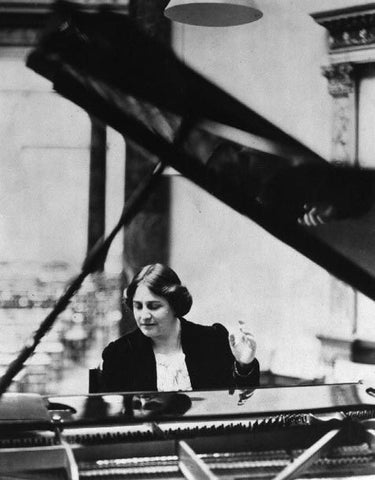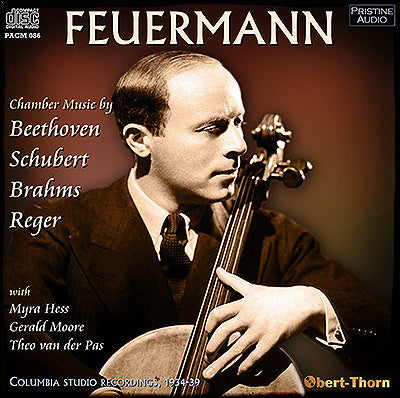Myra Hess

Dame Julia Myra Hess, DBE (25 February 1890 – 25 November 1965) was a British pianist.
Julia Myra Hess was born on 25 February 1890 to a Jewish family in Kilburn, London. The youngest of four children, she began playing the piano at an early age, starting lessons when she was five.. Two years later, she entered the Guildhall School of Music, where Hess graduated as winner of the Gold Medal. She studied at the Royal Academy of Music under Tobias Matthay. Her debut came in 1907 when she played Beethoven's Piano Concerto No. 4 with Sir Thomas Beecham conducting. She went on to tour through Britain, the Netherlands and France. Upon her American debut (New York City, 24 January 1922) she became a prime favourite in the United States, not only as a soloist, but also as a fine ensemble player. She also has a link to jazz, having given lessons in the 1920s to Elizabeth Ivy Brubeck, mother of Dave Brubeck.
Hess garnered greater fame during the Second World War when, with all concert halls blacked out at night to avoid being targets of German bombers, she organised what would turn out to be almost 2,000 lunchtime concerts spanning a period of six years, starting during the London Blitz. The concerts were held at the National Gallery, in Trafalgar Square; Hess herself played in 150 of them. For this contribution to maintaining the morale of the populace of London, King George VI awarded her with the Dame Commander of the Order of the British Empire (DBE) in 1941. (She had previously been created a CBE in 1936.) Hess makes a brief appearance performing at one of her lunchtime concerts in the 1942 wartime documentary Listen to Britain (directed by Humphrey Jennings and Stuart McAllister).
In 1946, Arturo Toscanini invited Hess to perform with the NBC Symphony Orchestra in New York City. According to Toscanini's biographer, Mortimer Frank, after Hess and the conductor had failed to agree on tempos for Beethoven's Fifth Piano Concerto, they decided instead to perform Beethoven's Third. The 24 November 1946 broadcast concert was preserved on transcription discs and later issued on CD by Naxos Records.
Hess was most renowned for her interpretations of the works of Mozart, Beethoven and Schumann, but had a wide repertoire, ranging from Domenico Scarlatti to contemporary works. She gave the premiere of Howard Ferguson's Piano Sonata and his Piano Concerto. She also played a good amount of chamber music and performed in a piano duo with Irene Scharrer. She promoted public awareness of the piano duo and two-piano works of Schubert.
In 1926 and 1934 she famously arranged for solo piano and for two pianos, respectively, the chorale Wohl mir, daß ich Jesum habe from Bach's Cantata Herz und Mund und Tat und Leben, BWV 147. This is Movement 6 of the cantata; the music is the same for Movement 10, Jesus bleibet meine Freude. Hess's arrangement was published under the title Jesu, Joy of Man's Desiring,[3] which is a translation of neither of these German titles but, roughly, of the unrelated work Jesu, meiner Seelen Wonne by Martin Janus. Furthermore, the melody, written in 1641, is by violinist Johann Schop, not Bach.
Her protégés included Clive Lythgoe and Richard and John Contiguglia and Leah (Celine) Benatar (Leah Labos) between 1941 and 1944, a noted linguist, cryptanalyst and Egyptologist. She was a teacher of Stephen Kovacevich (then known as Stephen Bishop).
Hess began her lunchtime concerts a few weeks after the commencement of the Second World War. They were presented weekdays, Monday through Friday, for six-and-a-half years without fail. If London was being bombed, the concert was moved to a smaller, safer room. Every artist was paid 5-guineas no matter who they were. In all, Hess presented 1,968 concerts seen by 824,152 people. Hess's lunchtime concerts influenced the formation of the City Music Society.
In September 1961, Hess played her final public concert at London's Royal Festival Hall. She was forced to retire after suffering a stroke in early 1961 while in New York on her annual concert tour in America. Although she courageously fought the debilitating effects of the stroke, by the end of the summer of that year it became clear that her public playing days were over. She continued to teach a handful of students, notably Stephen Kovacevich (then known as Stephen Bishop), during her last years.

Myra Hess
Dame Julia Myra Hess, DBE (25 February 1890 – 25 November 1965) was a British pianist.
Julia Myra Hess was born on 25 February 1890 to a Jewish family in Kilburn, London. The youngest of four children, she began playing the piano at an early age, starting lessons when she was five.. Two years later, she entered the Guildhall School of Music, where Hess graduated as winner of the Gold Medal. She studied at the Royal Academy of Music ...
SCHUBERT Arpeggione Sonata in A minor, D.821
BRAHMS Cello Sonata No. 1 in E minor, Op. 38
REGER Suite for Unaccompanied Cello in G Major, Op. 131c, No. 1
Recorded 1934-39
Total duration: 72:59
Emanuel Feuermann, cello
Myra Hess, piano
Gerald Moore, piano
Theo van der Pas, piano
SMETANA The Bartered Bride - Overture
LISZT Hungarian Rhapsody No. 12
BRAHMS Hungarian Dance No. 5
BRAHMS Hungarian Dance No. 6
DVOŘÁK Carnival Overture
DVOŘÁK Symphony No. 9
DVOŘÁK Slavonic Dance No. 1
Studio recordings, 1927-33
Total duration: 65:36
London Philharmonic Orchestra
Hallé Orchestra
Myra Hess, piano
Sir Hamilton Harty, piano, conductor
SCHUBERT Piano Trio No 1 in B flat, D898
BRAHMS Piano Trio No. 2 in C major, Op. 87
Recorded 1927 & 1935
Total duration: 61:26
Myra Hess, piano
Jelly d'Arányi, violin
Felix Salmond, cello
Gaspar Cassadó, cello
BEETHOVEN Piano Concerto No. 1
BEETHOVEN Piano Concerto No. 3 (two performances)
BEETHOVEN Piano Concerto No. 4
Live broadcast performances, 1944 & 1946
Total duration: 2hr 14:21
Ania Dorfmann, piano
Artur Rubinstein, piano
Rudolf Serkin, piano
Dame Myra Hess, piano
NBC Symphony Orchestra
conducted by Arturo Toscanini
SCHUBERT Symphony No. 6
SCHUMANN Piano Concerto
SCHUBERT Overture in E minor
Live recordings, 1956 et al
Total duration: 66:39
Dame Myra Hess, piano
Concertgebouw Orchestra of Amsterdam
conducted by Eduard van Beinum
BRAHMS Symphony No. 1 - Symphony No. 2 - Double Concerto - Song of Destiny - Tragic Overture - Hungarian Dance No. 17 - Symphony No. 3 - Symphony No. 4 - Piano Concerto No. 2 - Violin Concerto - Piano Concerto No. 1 - Haydn Variations - Alto Rhapsody - Academic Festival Overture - Un Requiem Tedesco (A German Requiem, sung in Italian)
Recorded 1941-1954
Bruno Walter, conductor
John Corigliano, violin
Leonard Rose, cello
Erica Morini, violin
Myra Hess, piano
Clifford Curzon, piano
Enid Szantho, contralto
Rosanna Carteri, soprano
Boris Christoff, bass
Philharmonic-Symphony Orchestra of New York
Hugo Strelitzer Choir
Hollywood Bowl Symphony Orchestra
Rome Symphony Orchestra & Chorus of RAI
-
Previous
- Page 1 of 2
- Next






